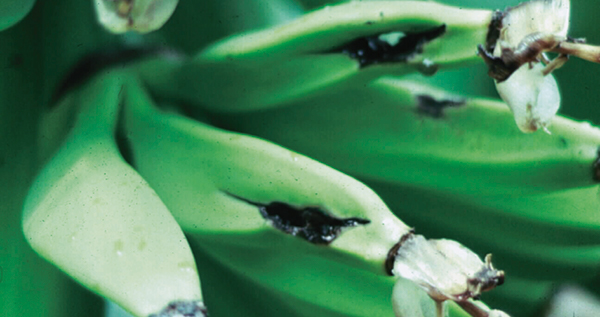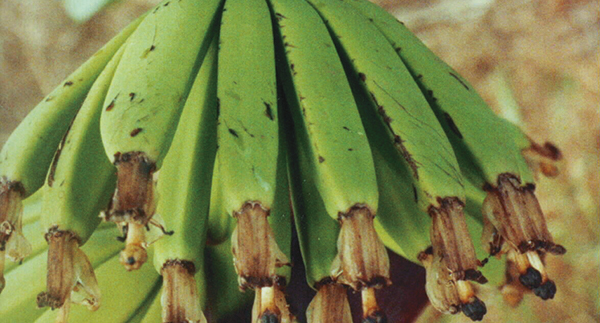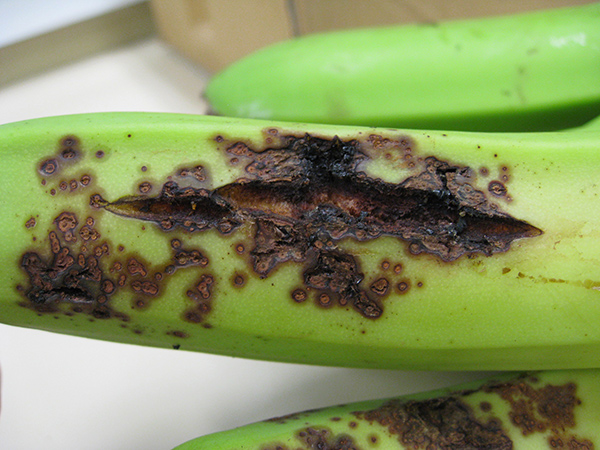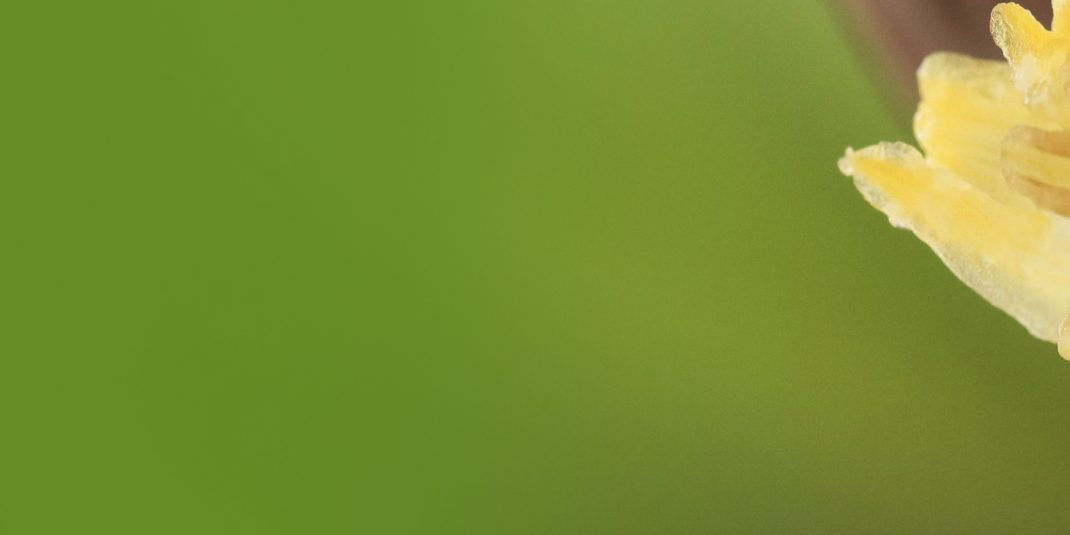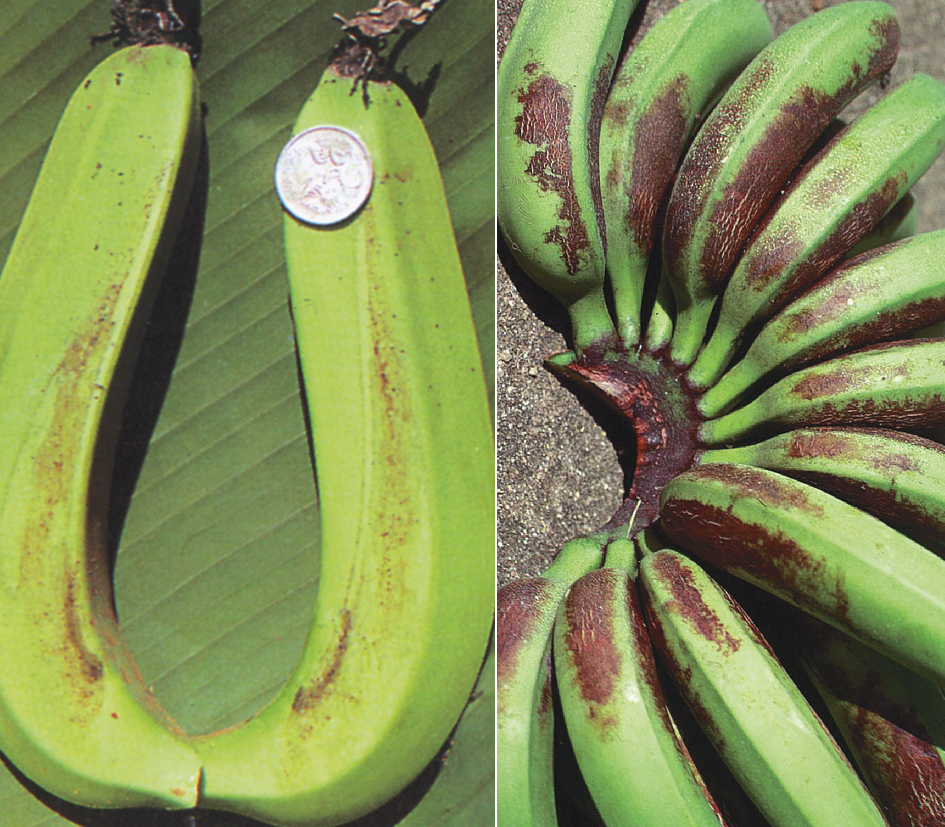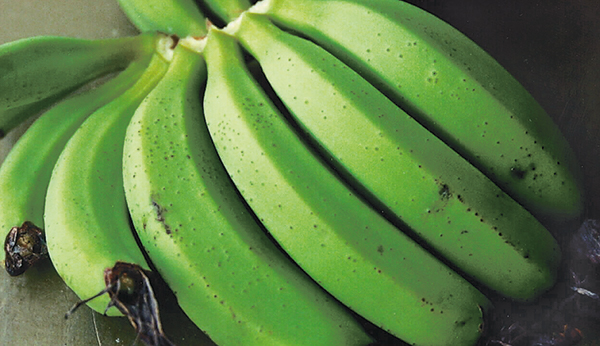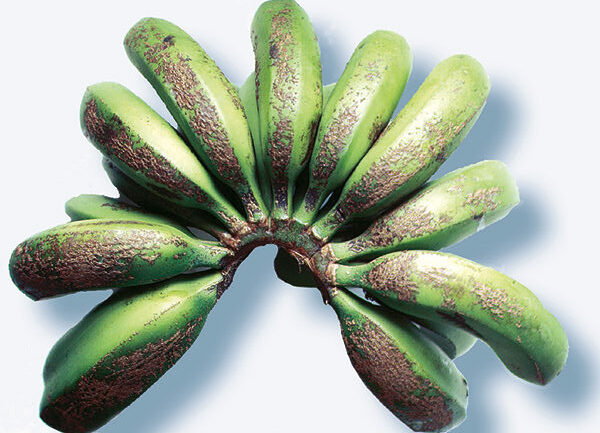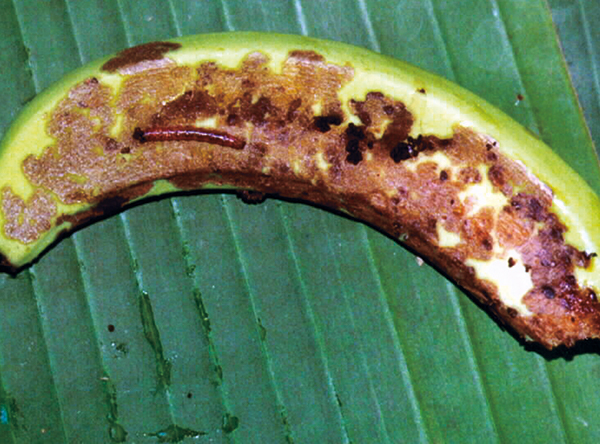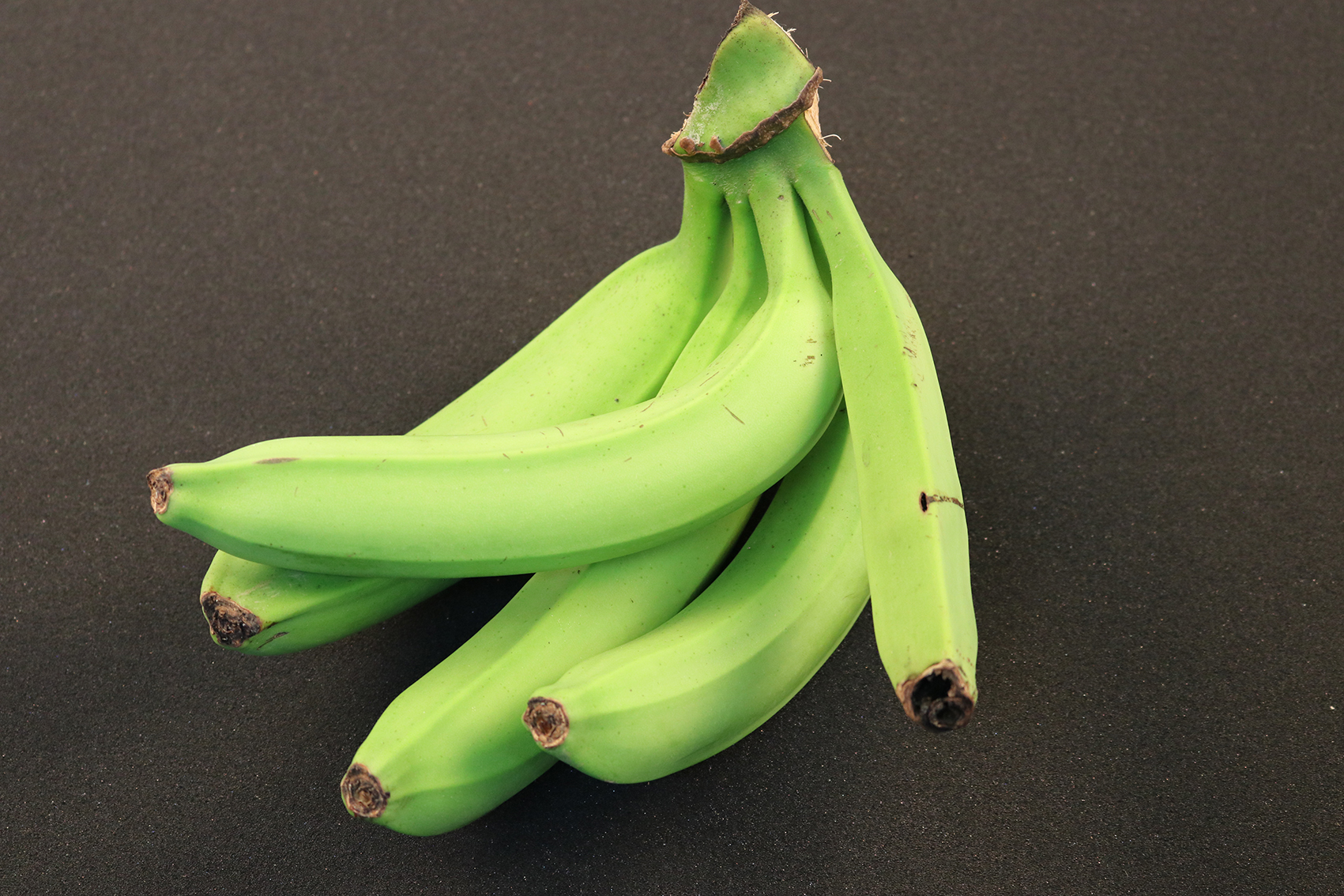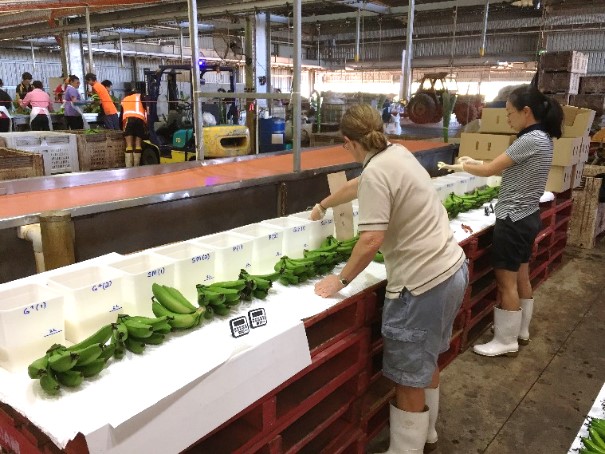Best management practices
Two complementary guidelines for best management practices (BMP) are now available to the Australian banana industry. These BMPs provide national guidelines to encourage continuous improvement and adoption of best practice in the banana industry. Both BMPs consist of a self-assessment checklist and corresponding information resources.
Best management practices: Environmental guidelines
This guide reflects the structure of the Freshcare Environmental code of practice, while providing specific banana industry content and best practice. The voluntary guideline provides a single point of reference for information relevant to environmental practices. Some of the practices have benefits that go beyond environmental interests and are practices that could potentially improve productivity and profitability.
The online system for this BMP allows you to electronically select the environmental practices that you have in place which will then:
- automatically generate a management plan (which can be used for some environmental auditing systems).
- allow you to action this management plan (e.g. assign budget and responsibilities to improve practices).
- allow you to anonymously compare your practices to moving industry benchmarks.
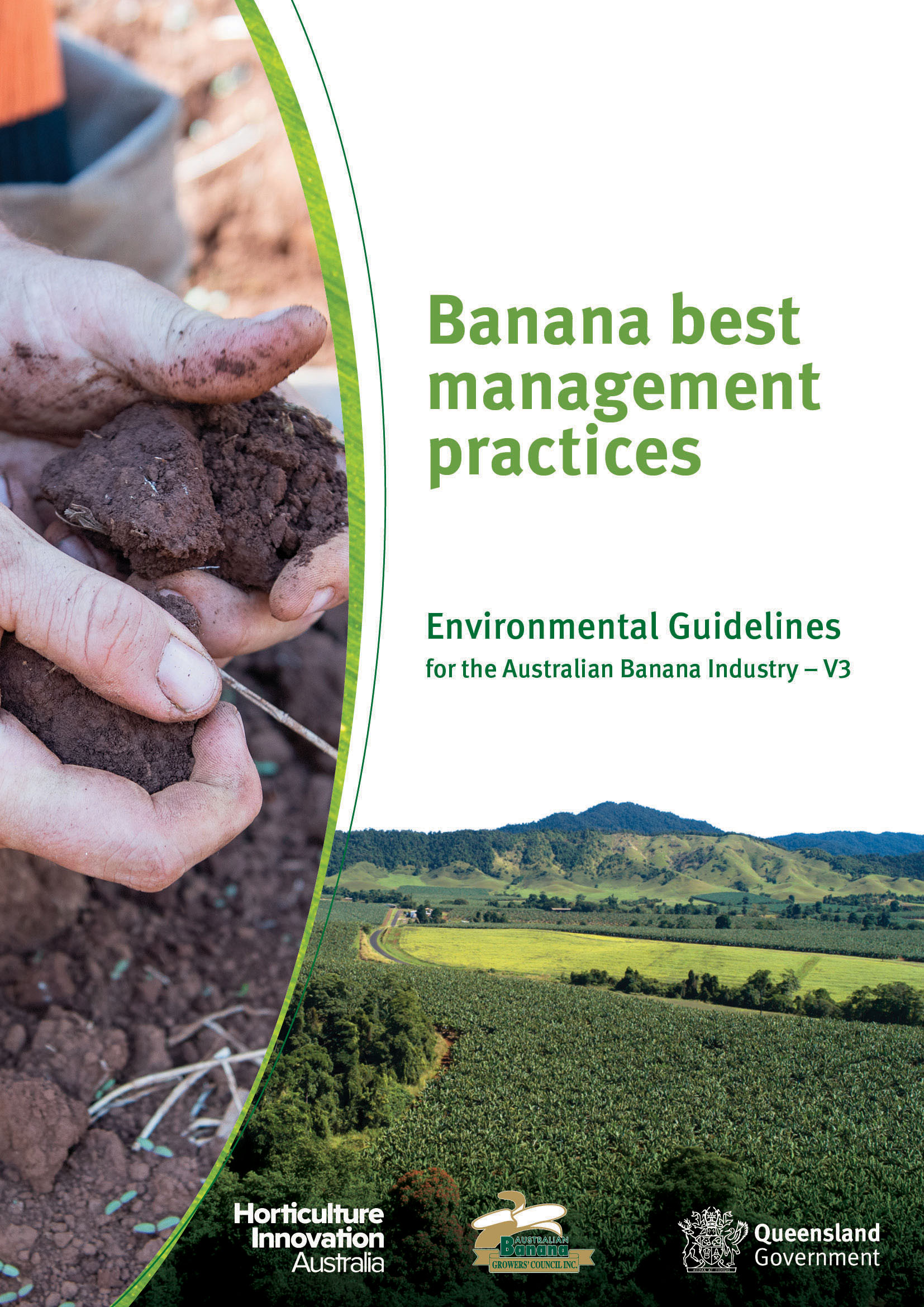
Login or download...
Did you know...
The banana industry’s ‘Better Bunch’ app is a time-saving device to assist growers to record their everyday farm practices to complement their BMP. If you complete your BMP on-line, you are currently able to access the app for free.
Best management practices: On-farm biosecurity
The Australian banana industry is vulnerable to pests and diseases. This best management practice (BMP) guideline can help growers implement effective on-farm biosecurity practices. It was developed following the detection of Panama disease tropical race 4 in Far North Queensland in 2015. It includes examples of on-farm biosecurity practices that are not only relevant to Panama disease but also minimises the risk of introducing other new pests, diseases and weeds onto your property.
The online system for this BMP allows you to electronically select the biosecurity practices that you have in place which will then:
- automatically generate a management plan.
- allow you to action this management plan (e.g. assign budget and responsibilities to improve practices).
- allow you to anonymously compare your practices to moving industry benchmarks.
Login or download…
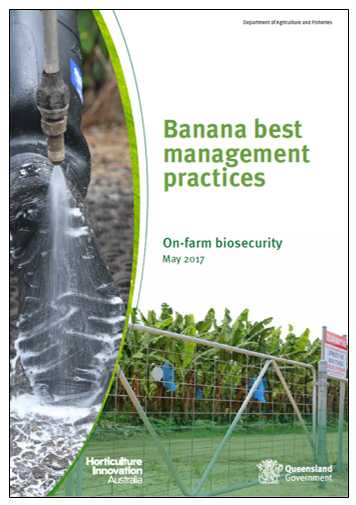
For more information on these BMP guidelines contact the better bananas team – betterbananas@daf.qld.gov.au or 13 25 23.
BMP: Environmental guidelines – The project was funded as part of Reefocus Extension, a Queensland Government Reef Plan initiative, working with growers to increase farm productivity and profitability and improve water quality in the Great Barrier Reef. This project was funded as part of the Developing a best management practices guideline for the Australian banana industry project (BA11006). This project was funded by Hort Innovation using the banana research and development levy, co-investment from the Queensland Department of Agriculture and Fisheries and contributions from the Australian Government.
BMP: On-farm biosecurity –This resource was developed as part of the Fusarium Wilt Tropical Race 4 – Biosecurity and Sustainable Solutions project (BA14013). This project was funded by Hort Innovation, using the banana research and development levy, with co-investment from the Queensland Department of Agriculture and Fisheries and funds from the Australian Government.
Hort Innovation is the grower-owned, not-for-profit research and development corporation for Australian horticulture.



Rust or bronzing on fruit
Rust or bronzing on fruit
Banana rust thrips
Cause: Feeding by Chaetanaphothrips signipennis from bract fall to harvest causes a rust brown skin discoloration. This symptom should not be mistaken for maturity bronzing, which is more prevalent on the outer exposed areas of the fingers.
Solution: Soil treatments for banana weevil borer will help control the soil thrips population. Treat bunches at the time of bunch covering.
More info:
Banana rust thrips — general information and monitoring and control options
More images
Maturity bronzing
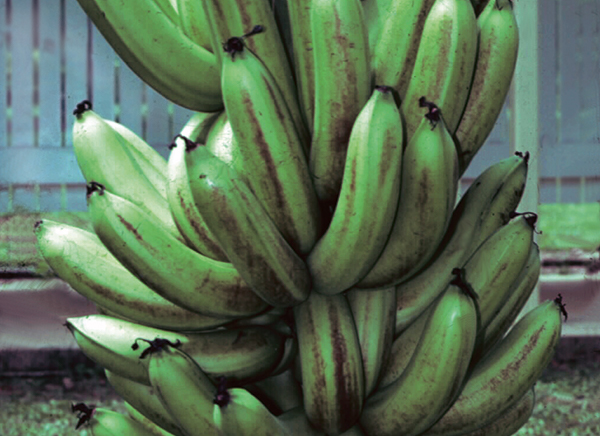
Cause: Oxidation of cell contents, possibly from a water and nutritional imbalance, causes the epidermal cells to discolour, lift and break.
Solution: In the short term, bunches should be harvested early before symptoms become more severe. Avoid water and nutrient stresses in the plant.
More info:
Maturity bronzing—stretching the limits on fruit quality
Spray burn
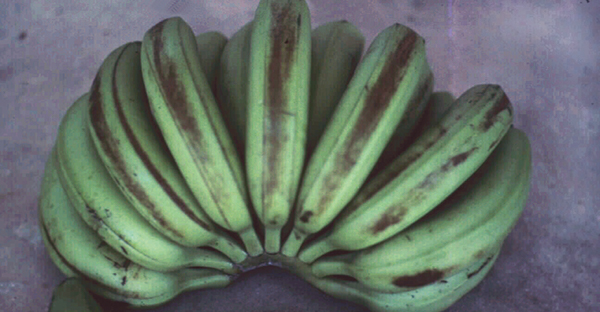
Cause: Incorrect chemical application rates, problems with compatibility or environmental conditions.
Solution: Check that you are using registered chemicals and are applying them at the correct rates. Make sure that your spray application equipment is cleaned regularly.
Silvering thrips
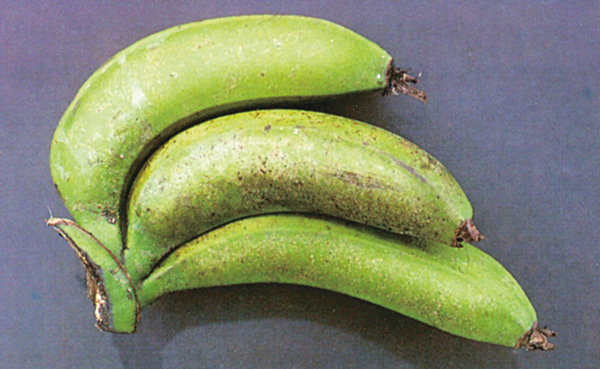
Cause: Feeding by Hercinothrips bicinctus.
Solution: This is a minor and rare pest of bananas grown in north Queensland. No specific treatments are required.
Mites
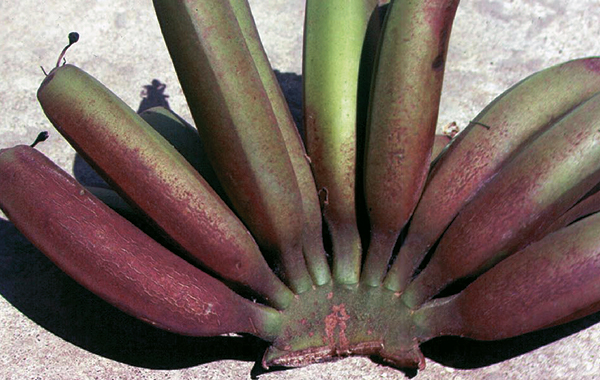
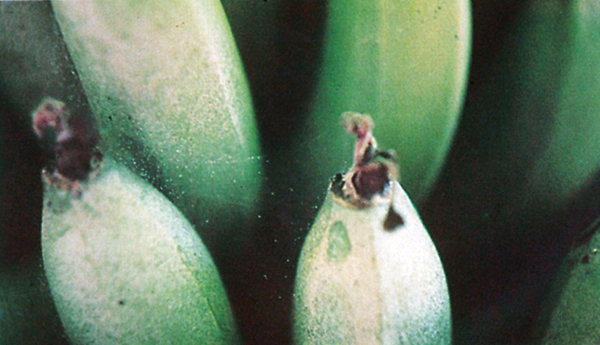
Cause: Banana (strawberry) spider mite, Tetranychus lambi, feeding on the fingers. More severe infestation will result in the damage spreading over the entire fingers.
Two-spotted mites, Tetranychus urticae, feed primarily on the tips of fingers, causing silver-grey superficial damage. Webbing forms ‘bridges’ between heavily infested fingers.
Solution: Severe mite outbreaks are usually the result of poor insecticide management, especially foliar application of disruptive pesticides that destroy beneficial species such as the Stethorus spp. beetle. Treatments with a suitable miticide may be required during periods of hot, dry weather when mite build-up can be rapid.
More info:
Spots of fruit
Spots on fruit
Banana freckle
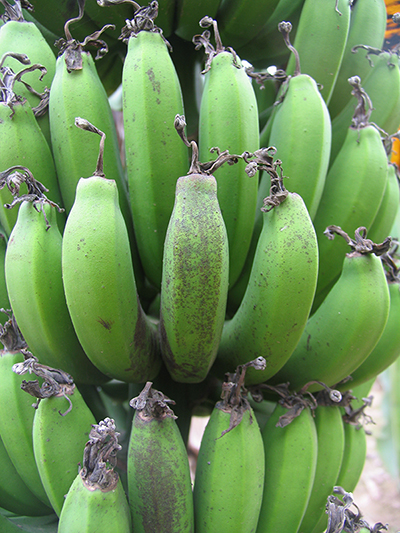
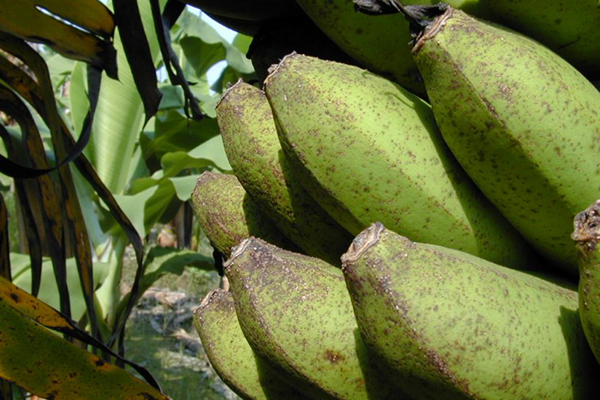
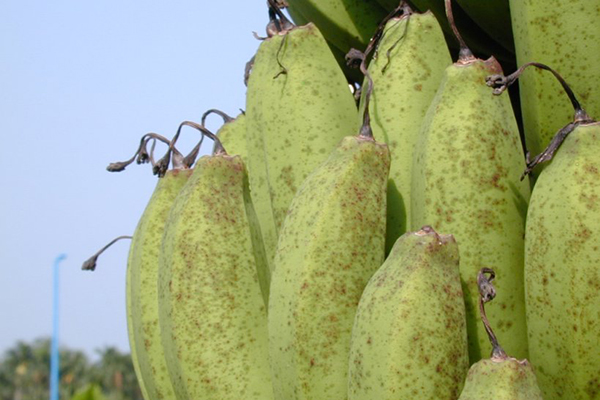
Biosecurity Alert
Cause: Banana freckle is a leaf and fruit spotting disease of banana and is caused by several species of the fungus Phyllosticta, some of which are exotic to Australia. The disease that affects Cavendish bananas is caused by the race Phyllosticta cavendishii, with the first incursion detected in Australia’s Northern Territory in 2013. This race can also affect non-Cavendish varieties.
Symptoms: The most distinguishing symptom of the disease are dark raised spots, and a sandpaper feel to infected (spotted) leaves and fruit. On fruit, individual spots first appear as minute, reddish-brown flecks surrounded by a halo of dark-green, water-soaked tissue.
Biosecurity: Both commercial and backyard banana growers should regularly monitor their banana plants for symptoms of the disease. If you see symptoms or anything unusual call Biosecurity Queensland on 13 25 23 or the Exotic Plant Pest Hotline on 1800 084 881 immediately.
Movement restrictions are in place to stop the movement of plants, plant material and fruit from infected or suspect premises. Further, Queensland, New South Wales and Western Australia prohibit the entry of banana fruit and plant material from the Northern Territory, with quarantine checkpoints at some state borders.
More info:
Plant Health Australia
Queensland Government
Northern Territory Government
Australian Government
ABGC
Symptoms of banana freckle on banana leaves (better bananas)
Banana spotting bug
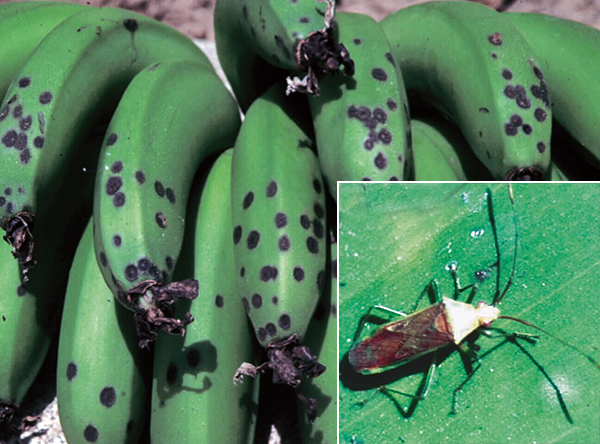
Cause: Feeding (sucking) by banana spotting bug, Amblypelta lutescens lutescens, usually on the exposed outer curve of the fingers.
Solution: Damage is more severe on blocks adjacent to rainforest. No specific treatments required. If more than 5% of bunches are affected, spot spray.
Fruit speckle
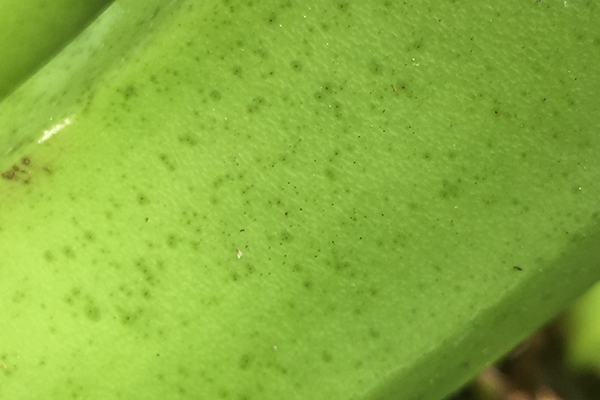
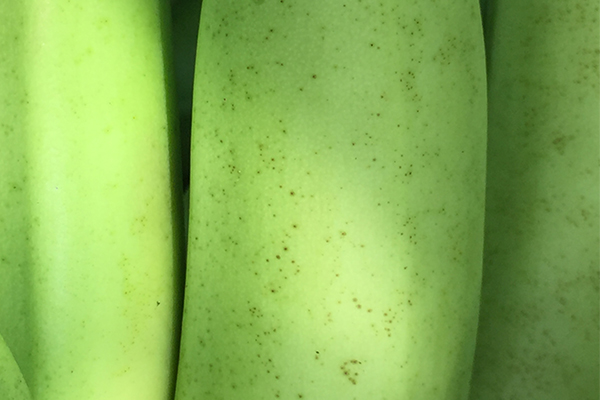
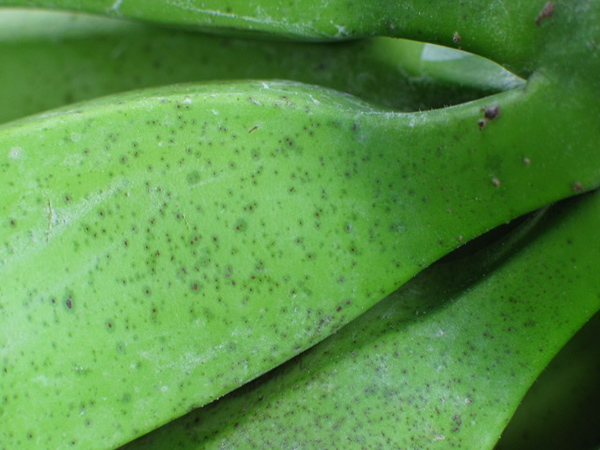
Cause: Caused by multiple species of fungi including Colletotrichum musae, Fusarium oxysporum and Fusarium semitectum. Spores are produced in large numbers on dead leaf material during wet conditions and are spread in air currents to the fruit.
Solution: Fruit speckle is generally a minor disease that can become problematic in seasonally unfavourable weather conditions. Under normal conditions, a fungicide leaf spot spray program should assist and keep levels low.
More info:
Deightoniella spot
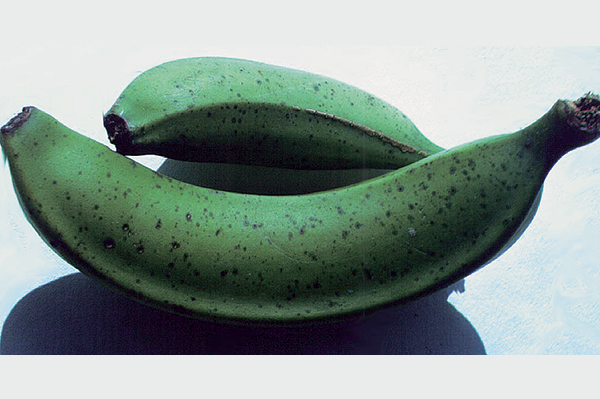
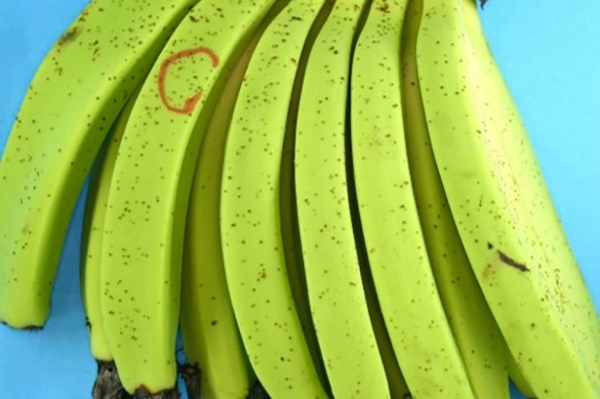
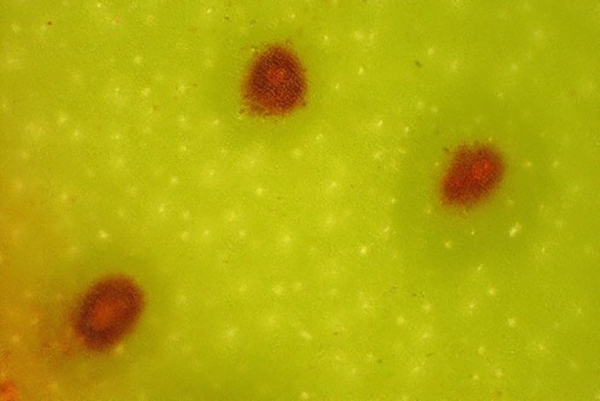
Cause: The fungus Deightoniella torulosa. Spores are produced in large numbers on dead leaf material during wet conditions and are spread in air currents to the fruit. Spots are typically larger than fruit speckle (2-4mm) and sunken on green fruit.
Solution: Deightoniella is generally a minor disease in well managed plantations that use a full leap spot control program.
More info:
A guide to identifying fungal fruit diseases
Fruit flies
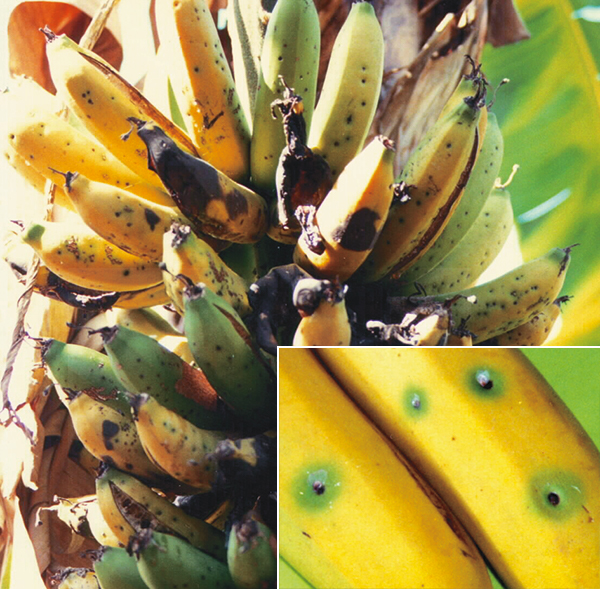
Cause: Banana fruit fly, Bactrocera musae, and Queensland fruit fly, Bactrocera tryoni, laying eggs (stinging) in the pulp of banana just below the skin. The banana fruit fly can sting green fruit but the Queensland fruit fly only stings ripening or yellow fruit.
Solution: Chemical control should not be required since fruit is harvested at the hard green stage before either of the fruit flies can complete their life cycles. Do not leave over ripe fruit in the field. If mixed ripe fruit causes hot spots in the plantation, spot spray with an appropriate chemical.
Flower thrips
Cause: Scarring from egg-laying by flower thrips, Thrips hawaiiensis on young fruit when still covered by the bracts.
Solution: Insecticide injection at bell emergence for control of scab moth also controls flower thrips.
More info:
Banana flower thrips – general information
Spray burn
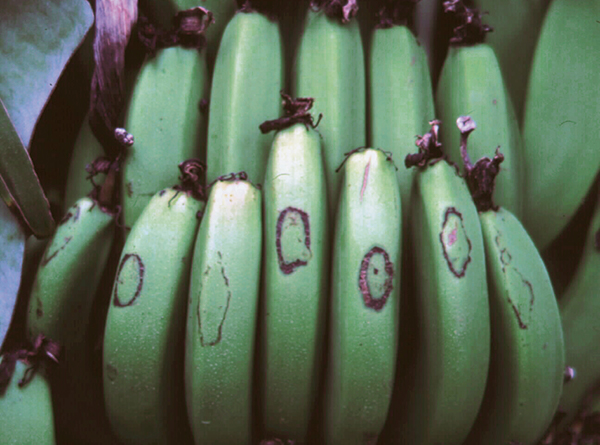
Cause: Spraying with excessive volumes of chemical or inappropriate chemical use.
Solution: Use only registered chemicals and apply according to the label directions.
Sooty blotch
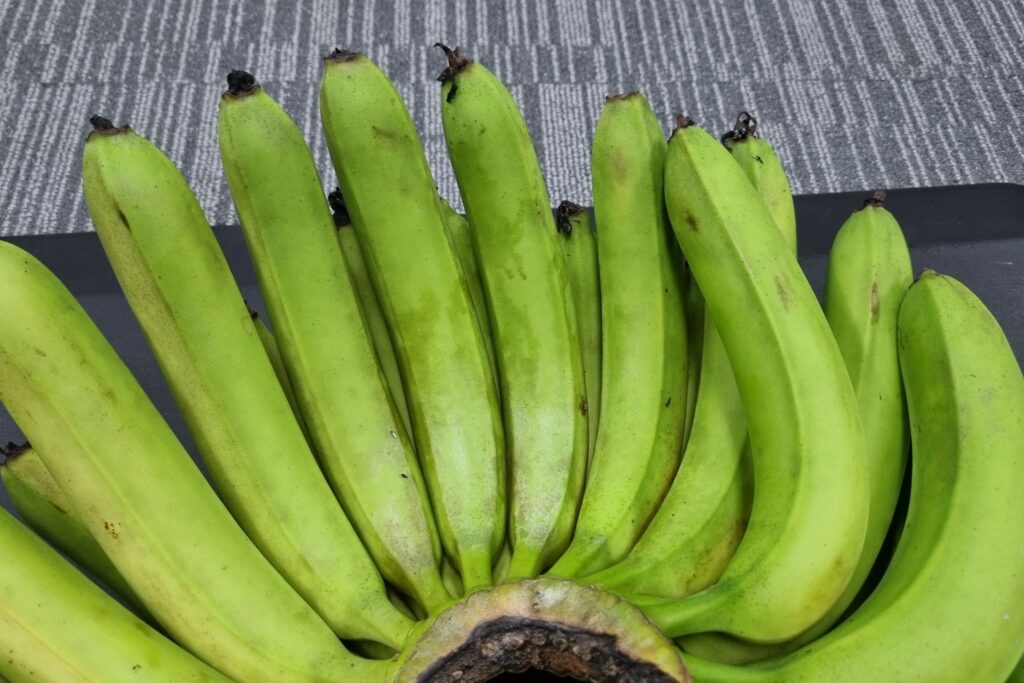
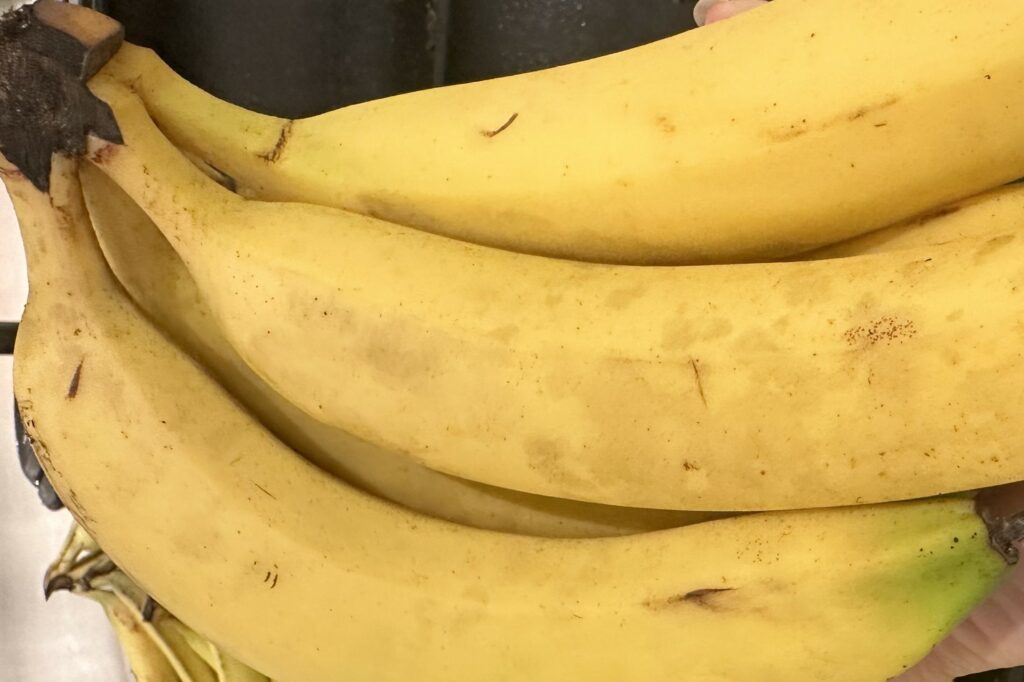
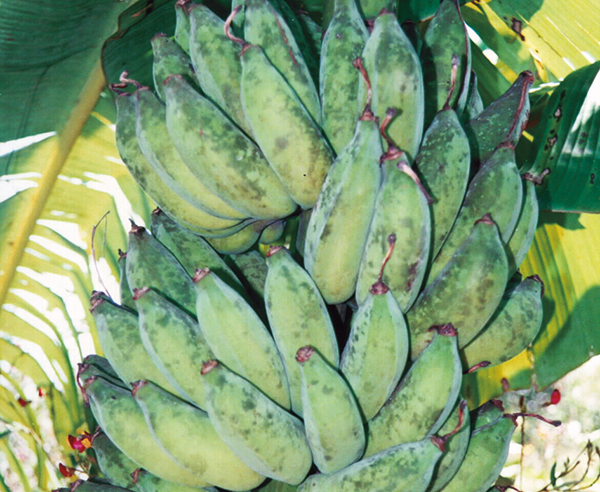
Cause: Multiple fungal organisms are associated with the symptoms. Causes superficial damage to the banana peel and typical symptoms are charcoal-like smudges that are dark and irregular in shape.
Solution: Lady Finger and Ducasse are more prone to sooty blotch than Cavendish-type bananas. A post-harvest dip of sodium hypochlorite at 100 ppm for 5 minutes followed by immediate rinsing, is highly effective in removing sooty blotch.
More info:
Sooty mould
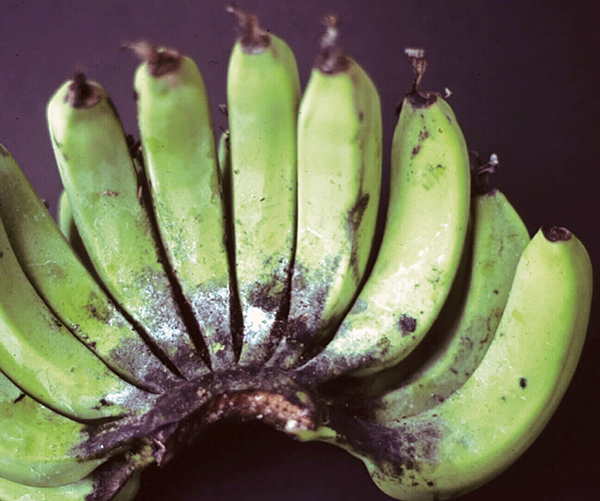
Cause: Sooty mould fungi that develop on the honeydew secretions of the banana aphid, Pentalonia nigronervosa.
Solution: Natural control by parasites and predators provides adequate suppression. Infestations are more obvious during cooler weather in autumn and spring. Spot treatment with a suitable pesticide is occasionally required as the mould can be difficult to remove from fruit.
More info:
Scabs on fruit
Scabs on fruit
Banana fruit caterpillar
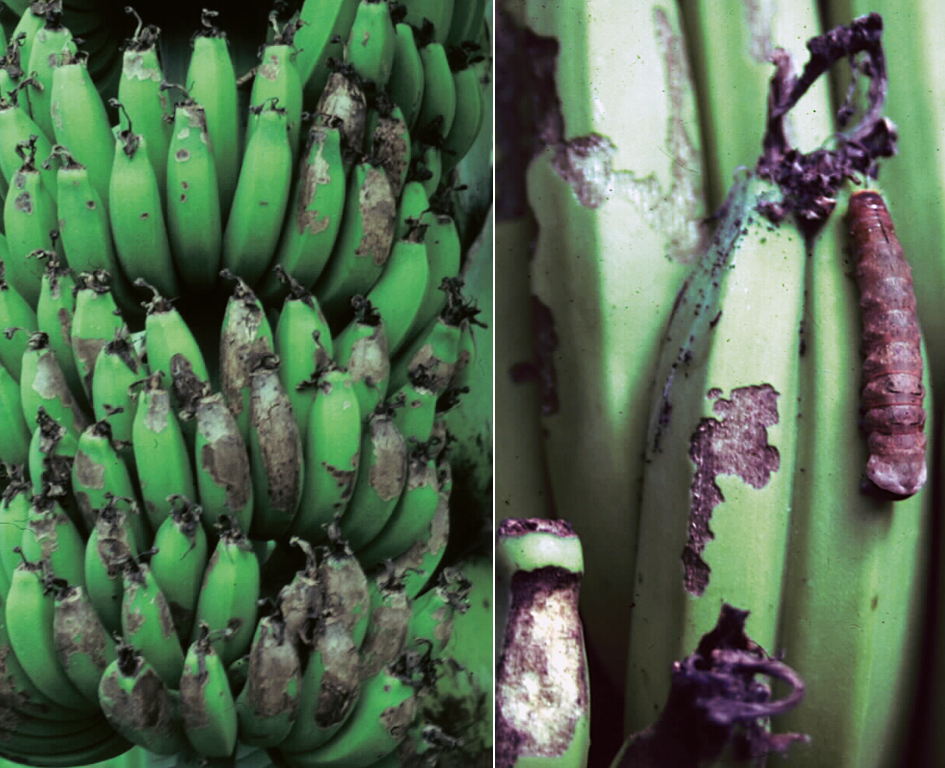
Cause: Larvae of Tiracola plagiata feeding on leaves and fruit. Damage is usually confined to a few bunches and feeding on fruit is confined to the outside of fingers.
Solution: Although attack to a single bunch can be very severe, only a few bunches are damaged and specific treatments are not usually needed. Standard treatments for rust thrips and sugarcane bud moth help to control fruit caterpillar. If damage is noted on more than 5% of bunches, treat with a pesticide.
Corky scab
Cause: Scarring from feeding and egg-laying by flower thrips, Thrips hawaiiensis on young fruit when still covered by the bracts.
Solution: Insecticide injection at bell emergence for control of scab moth also controls flower thrips.
More info:
Banana flower thrips – Summary
Rub
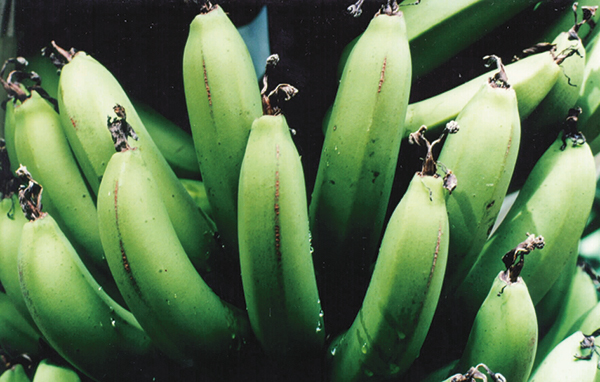
Cause: Rubbing between the bag and young fingers due to prolonged strong winds. Leaves rubbing against the fruit cause similar symptoms.
Solution: Retaining existing vegetation or planting specific windbreak trees can reduce the damage caused by strong winds.
Scab moth
Cause: Larvae of Nacoleia octasema feeding on the fruit between the bunch stalk and the hand. Only occurs from bunch emergence to bract fall.
Solution: Newly emerged bells require pesticide injection while they are still upright. When the plants are growing quickly during summer, treat blocks at least weekly.
More info:
Banana scab moth – summary
Sugarcane bud moth
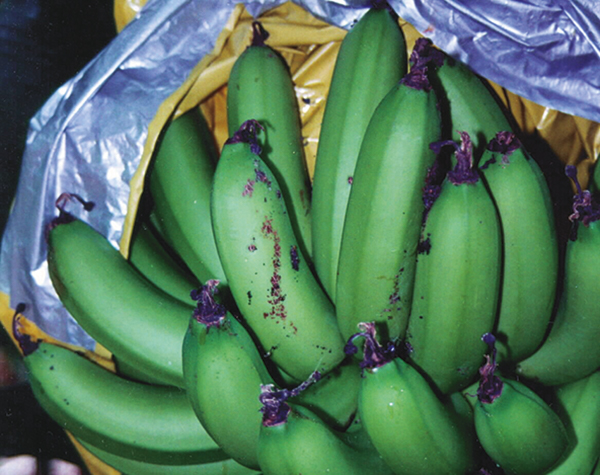
Cause: Small grey larvae of Opogona glycyphaga. They feed and pupate mainly towards the tips of the fingers and where the flower end of a lower finger meets a finger in the hand above.
Solution: This pest lays its eggs on fruit after all the bracts have fallen. Treat bunches with insecticide during bunch covering.
Deformed or variegated fruit
Deformed or variegated fruit
Mokillo
Cause: The disease is caused by multiple bacterium complexes. This includes Pseudomonas sp. and two bacteria from the Enterobacteraceae family; Pantoea agglomerans and Enterobacter cowanii, that have been frequently recovered from infected fruits. The bacteria occur naturally on flowers and may be transferred to other flowers by insects. Frequently only one finger per hand is infected. The problem is more prevalent in the wet season.
Solution: Control is not warranted.
More images
Nectaries (black spot inside banana tips)
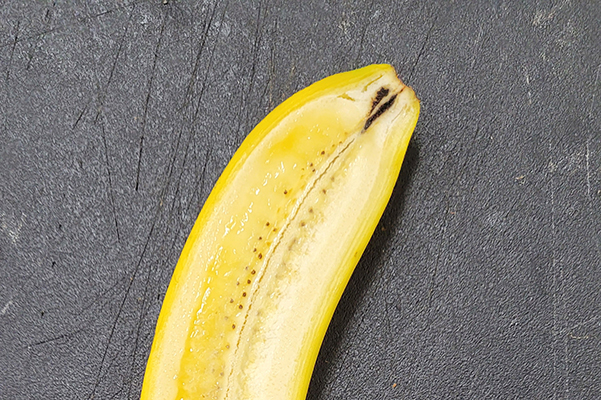
Cause: Oxidation of the anatomical structure of the fruit (nectary).
Solution: Control is not warranted.
More info:
Better Bananas article on nectaries
Tissue-cultured off-type
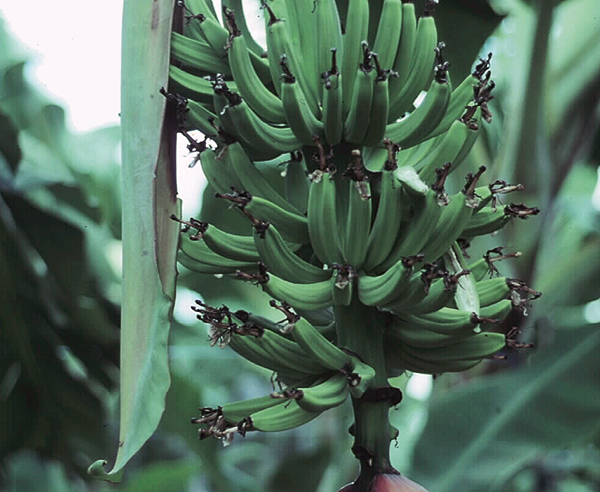
Cause: A genetic abnormality occurring in tissue-cultured plants.
Solution: Destroy affected plants and set additional following suckers on nearby plants.
Cold weather
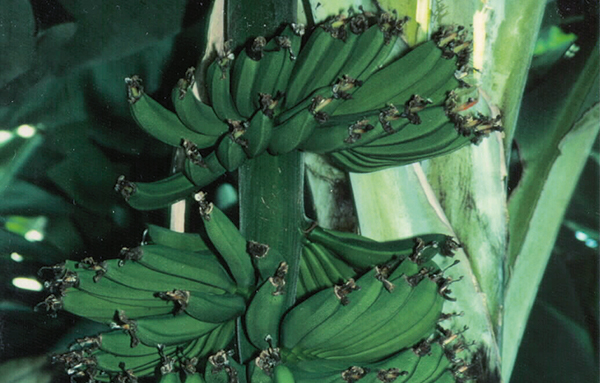
Cause: Temperatures below 6°C lead to abnormal growth. The more hours of exposure and the lower the temperature, the greater the damage.
Solution: Very early bunch covering before bract lifting will raise the bunch temperature by 1 to 2°C.
November dumps
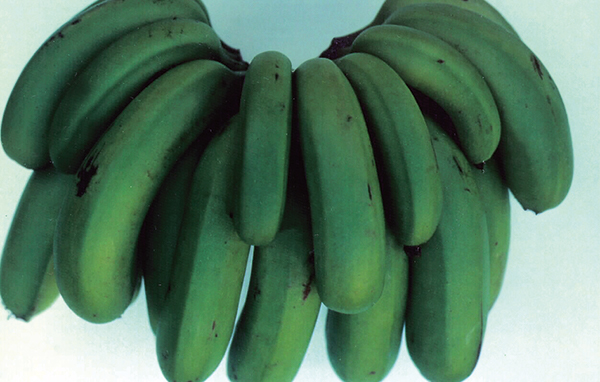
Cause: Bunch initiation coinciding with night temperatures below 6°C in winter. These bunches normally emerge in October and November.
Solution: Seldom a problem in north Queensland. Plant crops are affected more than ratoons, so time planting to avoid bunch initiation during mid-winter.
Genetic abnormality (variegated fruit)
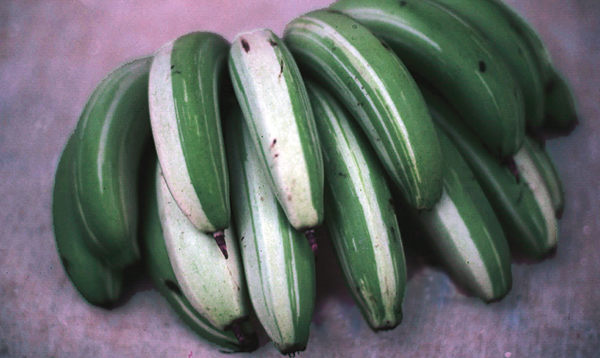
Cause: A genetic abnormality that occurs in tissue-cultured plants.
Solution: Destroy affected plants and set additional following suckers on nearby plants.
Elementor #71583
Add Your Heading Text Here
Resistance to current post-harvest chemical trials
Resistance to current post-harvest chemical trials
Lab testing used to indicate whether a fungal organism has developed resistance to a particular post-harvest fungicide is commonly termed ‘sensitivity testing’. Sensitivity testing has been carried out on the two registered post-harvest products (prochloraz – Protak® and thiabendazole – Tecto®), against each of the four fungi known to be responsible for causing crown end rot (Fusarium spp., Colletotrichum musae, Musicillium theobromae and Thielaviopsis musarum, commonly known as Chalara).
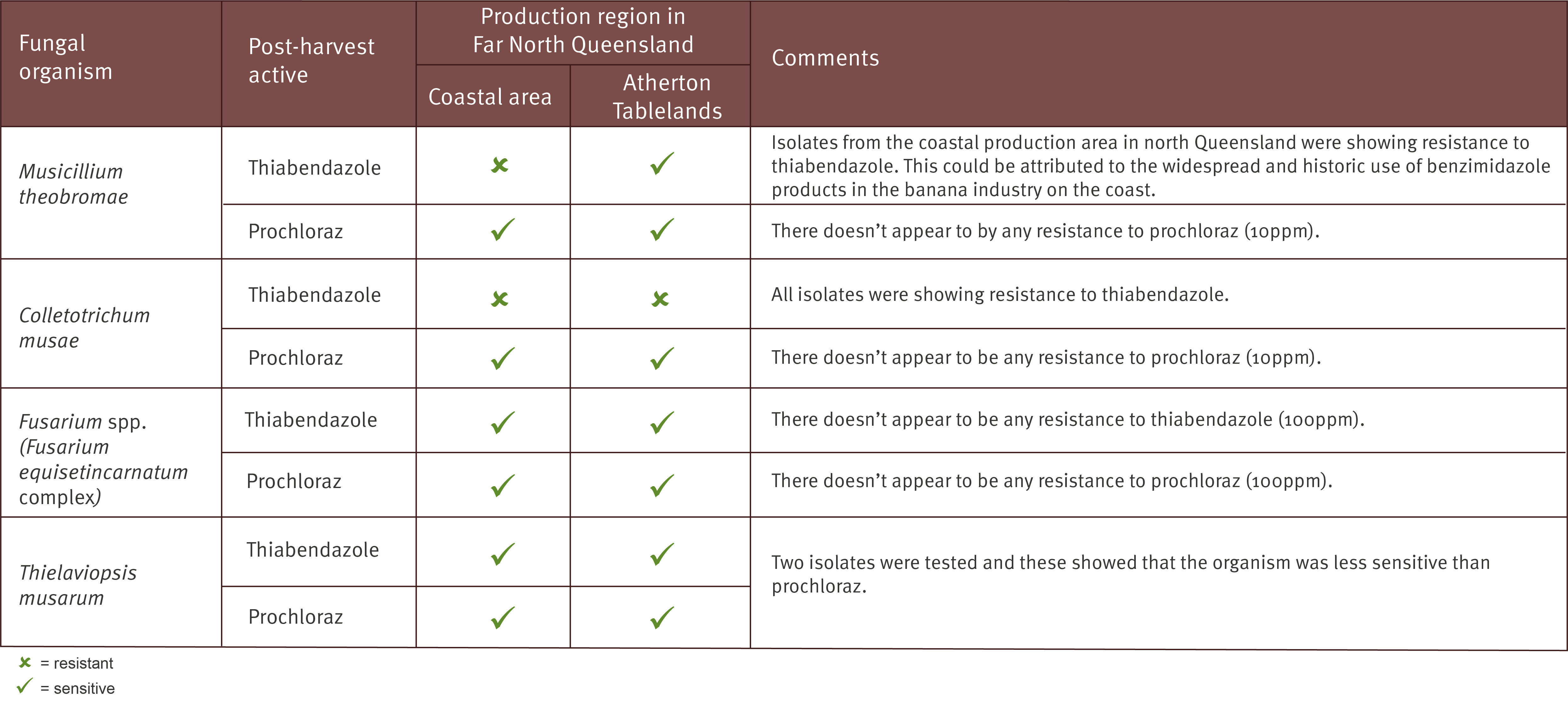
These results show that it may be necessary to change your post-harvest treatment products, depending on the organism/s you are having issues with and the location of your farm.
If you would like more information on this trial contact the better bananas team at betterbananas@daf.qld.gov.au or 13 25 23.
This work is funded as part of the Cause and management of crown rot of banana project (BA13011). This project is funded by Hort Innovation, using the banana research and development levy, co-investment from the Queensland Department of Agriculture and Fisheries and contributions from the Australian Government. Hort Innovation is the grower-owned, not-for-profit research and development corporation for Australian horticulture.


Dans test with new post template
Recognition of Agrobaterium by the plant
“To initiate the tumorous state, cells of Agrobacterium must first attach to a wound site on the plant. Molecular evidence suggests that the recognition of Agrobacterium by plant tissue involves complementary receptor molecules on the surfaces of the bacterial and plant cells. It is though that the plant receptor molecule is a type of pectin and that the bacterial receptor is a type of plysaccaride containing Beta-glucans.”
(Brock and Maddigan 1991)
Time in supply chain studies
Time in supply chain studies
The length of time bananas spend in the supply chain can have a significant impact on the development of crown end rot (CER).
Researchers conducted a simulation experiment, where Cavendish (Williams) and Lady Finger clusters were held 1, 2, 3 and 4 weeks prior to being ripened. The fruit for the experiments was sourced from a commercial property and all fruit was treated with a post-harvest chemical (prochloraz). To ensure a fair comparison, fruit from different positions in the bunch (top, middle and bottom hands) were assessed in case this was also a contributing factor. Once the fruit was ripened, the symptom development of CER was rated on a scale of 0-7 (7 being the most severe).
As seen in the graph below, the experiment with Cavendish fruit revealed fruit held longer within the supply chain resulted in relatively more severe symptoms of CER than fruit that would generally move through quicker. However, the overall symptom development was low as you can see in the graph below.
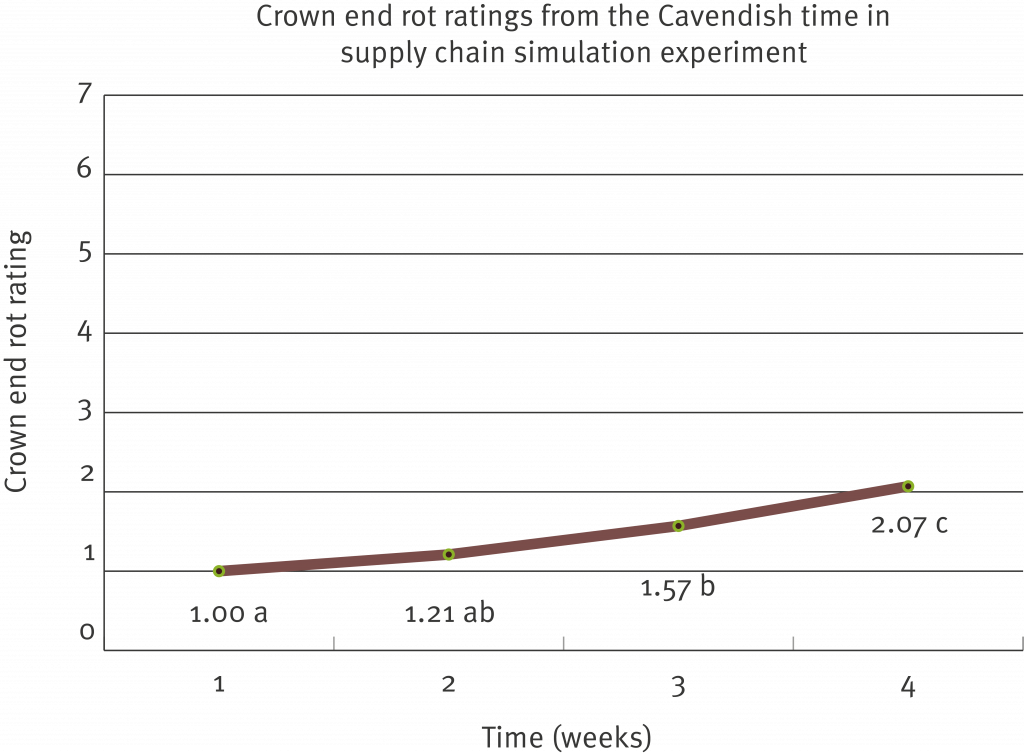
As seen in the figure below, the simulation experiment using Lady Fingers showed similar results to Cavendish fruit in that fruit held for longer prior to ripening produced more severe symptoms of CER. However the overall symptom development was low as you can see in the graph below.
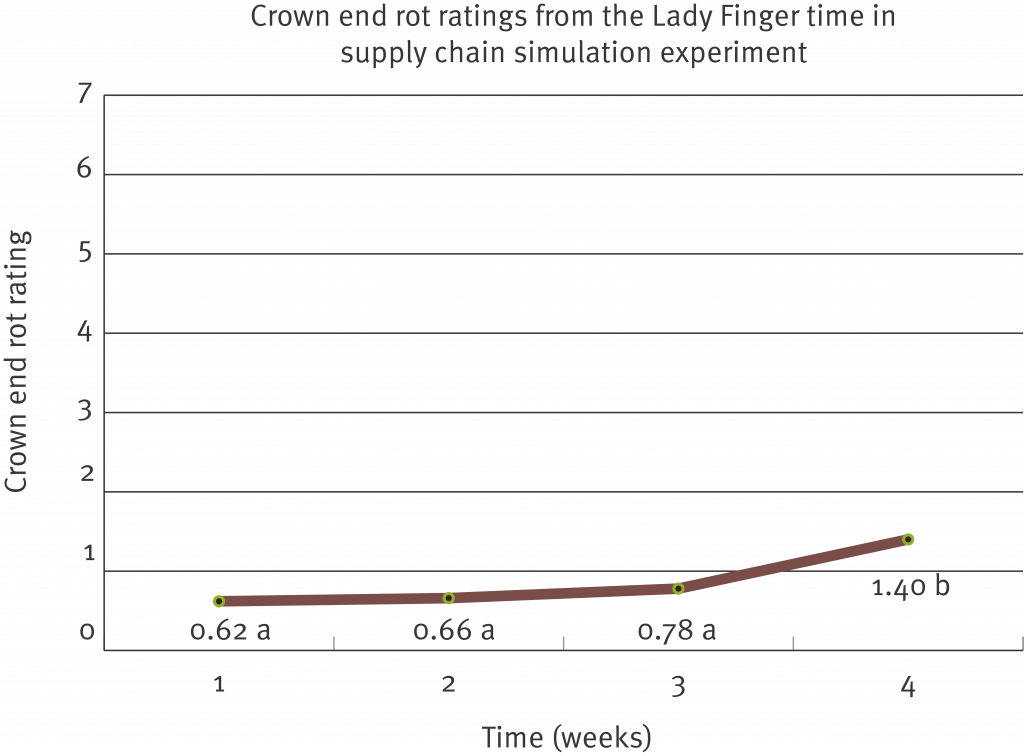
If you would like more information on this trial contact the better bananas team at betterbananas@daf.qld.gov.au or 13 25 23.
This work is funded as part of the Cause and management of crown rot of banana project (BA13011). This project is funded by Hort Innovation, using the banana research and development levy, co-investment from the Queensland Department of Agriculture and Fisheries and contributions from the Australian Government. Hort Innovation is the grower-owned, not-for-profit research and development corporation for Australian horticulture.



